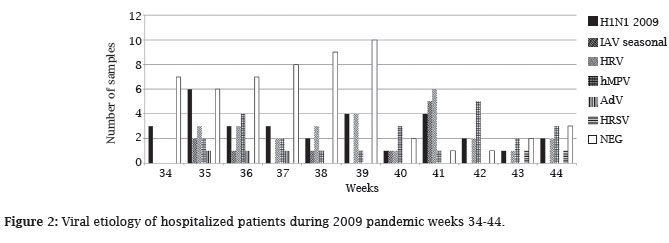INTRODUCTION: During the first pandemic wave of the influenza A H1N1 2009 virus, morbidity was particularly high in Brazil. Hospitalizations resulting from severe respiratory disease due to suspected influenza-like illness created an opportunity to identify other respiratory viruses causing lower respiratory infections. OBJECTIVE: The purpose of this study was to assess viral etiologies among samples collected during the first pandemic wave of H1N1 2009 from hospitalized patients with suspected cases in a Brazilian Sentinel Hospital. PATIENTS AND METHODS: Viral etiologies were investigated in samples from 98 children and 61 adults with fever, cough and dyspnea who were admitted to São Paulo Sentinel Hospital with suspected H1N1 infection. RESULTS: From August to November 2009, in 19.5% (31/159) of the samples 2009 H1N1 virus was detected with 23% (14/61) in adults (median age 25 years, range: 14-55 years) and 18.4% (17/92) in children (median age 5 years, range: 4 months - 11 years). Among the negative samples, a wide range of causative etiologic agents was identified. Human rhinovirus was the most frequent virus (23.91%) in children and human metapneumovirus (11.48%) was the second most frequent in adults, following 2009 H1N1 virus (22.95%). CONCLUSION: These data highlight the need to diagnose other viral infections that can co-circulate with influenza and may have been neglected by physicians as causes of severe respiratory diseases.
influenza virus; influenza A H1N1 2009 virus; rhinovirus; human metapneumovirus; human respiratory syncytial virus; respiratory viruses



